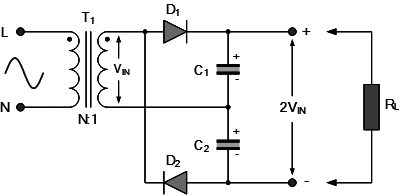
Why do we use a multiplier with a voltmeter?
Answer
216k+ views
Hint: The device used to measure the electric potential difference between two locations in an electric circuit is called a voltmeter. It has parallel connections. It typically has a high resistance such that it uses very little circuit current. A galvanometer and series resistor can be used to make analogue voltmeters, which move a pointer across a scale in proportion to the voltage detected. Microvolts or less can be measured using metres that use amplifiers.
Complete answer:
By attaching a multiplier, the voltage that indicates the voltmeter's range may be raised. A resistor is all that the multiplier is. To raise the voltmeter's resistance, the multiplier and voltmeter are linked in series.
In that they convert AC voltages to DC voltages for use in a variety of electrical and electronic circuit applications, such as microwave ovens, powerful electric field coils for cathode-ray tubes, electrostatic and high voltage test equipment, etc., where it is necessary to have a very high DC voltage generated from a relatively low AC supply, voltage multipliers are similar in many ways to rectifiers.
A rectifier circuit's DC output voltage (Vdc) is typically constrained by the sinusoidal input voltage's peak value. However, by combining rectifier diodes and capacitors, we may double this input peak voltage to produce a DC output that is an odd or even multiple of the AC input voltage peak voltage. A simple voltage multiplier circuit is shown below.

Note: Voltmeters come in a broad variety of designs, some powered independently (by a battery, for example), and some powered directly by the source of the voltage being measured. Generators and other stationary equipment are monitored by instruments that are permanently positioned in a panel. Standard test tools are used in electrical and electronic work and are often portable equipment with a multimeter that can also measure current and resistance. Any measurement that can be converted to a voltage, such as pressure, temperature, flow, or level in a chemical processing facility, can be shown on a properly calibrated metre.
Complete answer:
By attaching a multiplier, the voltage that indicates the voltmeter's range may be raised. A resistor is all that the multiplier is. To raise the voltmeter's resistance, the multiplier and voltmeter are linked in series.
In that they convert AC voltages to DC voltages for use in a variety of electrical and electronic circuit applications, such as microwave ovens, powerful electric field coils for cathode-ray tubes, electrostatic and high voltage test equipment, etc., where it is necessary to have a very high DC voltage generated from a relatively low AC supply, voltage multipliers are similar in many ways to rectifiers.
A rectifier circuit's DC output voltage (Vdc) is typically constrained by the sinusoidal input voltage's peak value. However, by combining rectifier diodes and capacitors, we may double this input peak voltage to produce a DC output that is an odd or even multiple of the AC input voltage peak voltage. A simple voltage multiplier circuit is shown below.

Note: Voltmeters come in a broad variety of designs, some powered independently (by a battery, for example), and some powered directly by the source of the voltage being measured. Generators and other stationary equipment are monitored by instruments that are permanently positioned in a panel. Standard test tools are used in electrical and electronic work and are often portable equipment with a multimeter that can also measure current and resistance. Any measurement that can be converted to a voltage, such as pressure, temperature, flow, or level in a chemical processing facility, can be shown on a properly calibrated metre.
Recently Updated Pages
Circuit Switching vs Packet Switching: Key Differences Explained

Mass vs Weight: Key Differences Explained for Students

Alpha, Beta, and Gamma Decay Explained

Alpha Particle Scattering and Rutherford Model Explained

Angular Momentum of a Rotating Body: Definition & Formula

Apparent Frequency Explained: Formula, Uses & Examples

Trending doubts
JEE Main 2026: Application Form Open, Exam Dates, Syllabus, Eligibility & Question Papers

JEE Main Correction Window 2026 Session 1 Dates Announced - Edit Form Details, Dates and Link

Derivation of Equation of Trajectory Explained for Students

Hybridisation in Chemistry – Concept, Types & Applications

Understanding the Angle of Deviation in a Prism

Understanding Collisions: Types and Examples for Students

Other Pages
JEE Advanced Marks vs Ranks 2025: Understanding Category-wise Qualifying Marks and Previous Year Cut-offs

How to Convert a Galvanometer into an Ammeter or Voltmeter

Atomic Structure: Definition, Models, and Examples

Ideal and Non-Ideal Solutions Explained for Class 12 Chemistry

Degree of Dissociation: Meaning, Formula, Calculation & Uses

Understanding Electromagnetic Waves and Their Importance




